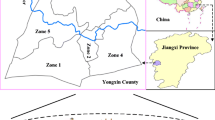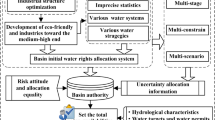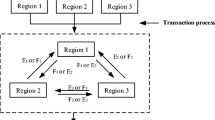Abstract
Although the risk-explicit interval linear programming (REILP) model has solved the problem of having interval solutions, it has an equity problem, which can lead to unbalanced allocation between different decision variables. Therefore, an improved REILP model is proposed. This model adds an equity objective function and three constraint conditions to overcome this equity problem. In this case, pollution reduction is in proportion to pollutant load, which supports balanced development between different regional economies. The model is used to solve the problem of pollution load allocation in a small transboundary watershed. Compared with the REILP original model result, our model achieves equity between the upstream and downstream pollutant loads; it also overcomes the problem of greatest pollution reduction, where sources are nearest to the control section. The model provides a better solution to the problem of pollution load allocation than previous versions.








Similar content being viewed by others
References
Aly AH, Peralta RC (1999) Comparison of a genetic algorithm and mathematical programming to the design of groundwater clean up systems. Water Resour Res 35(8):2415–2425
Burn DH, Yulianti JS (2001) Waste-load allocation using genetic algorithms. J Water Resour Plan Manag 127(2):121–129
Chinneck JW, Ramadan K (2000) Linear programming with interval coefficients. J Oper Res Soc 51(2):209–220
Dhar A, Datta B (2008) Optimal operation of reservoirs for down-stream water quality control using linked simulation optimization. Hydrol Process 22(6):842–853
Guan JB, Aral MM (2004) Optimal design of groundwater remediation systems using fuzzy set theory. Water Resour Res 40(1):62–74
Huang YF, Li JB, Huang GH, Chakma A, Qin XS (2003) Integrated simulation–optimization approach for real-time dynamic modeling and process control of surfactant-enhanced remediation at petroleum-contaminated sites. Pract Period Hazard Toxic Radioact Waste Manag 7(2):95–105
Irish LB, Barrett ME, Malina J, Charbeneau RJ (1998) Use of regression models for analyzing highway storm-water loads. J Environ Eng 124(10):987–993
Johnson VM, Rogers LL (2000) Accuracy of neural network approximations in simulation–optimization. J Water Resour Plan Manag 126(2):48–56
Kartal S, Ozer U (1998) Determination and parameterization of some air pollutants as a function of meteorological parameters in Kayseri, Turkey. J Air Waste Manag Assoc 48(9):853–859
Lall U, Moon YI, Kwon HK, Bosworth K (2006) Locally weighted polynomial regression: parameter choice and application to forecasts of the great salt Lake. Water Resour Res 42(5):1–31
Liang B, Wang XY (2005) The current situation and expectation of our country water environment contamination gross control. J Cap Norm Univ 26(1):93–98
Liu Y, Zou R, Guo HC (2011a) Risk explicit interval linear programming model for uncertainty-based nutrient-reduction optimization for the lake Qionghai watershed. J Water Resour Plan Manag 137:83–91
Liu Y, Zou R, Riverson J, Yang P, Guo HC (2011b) Guided adaptive optimal decision making approach for uncertainty based watershed scale load reduction. Water Res 45(16):4885–4895
Morris MD (1991) Factorial sampling plans for preliminary computational experiments. Technometrics 33:161–174
Muxika I, Borja A, Bald J (2007) Using historical data, expert judgement and multivariate analysis in assessing reference conditions and benthic ecological status, according to the European water framework directive. Mar Pollut Bull 55(1):16–29
Oliveira C, Antunes CH (2007) Multiple objective linear programming models with interval coefficients—an illustrated overview. Eur J Oper Res 181(3):1434–1463
Qin XS, Huang GH, Zeng GM, Chakma A (2008) Simulation based optimization of dual-phase vacuum extraction to remove non-aqueous phase liquids in subsurface. Water Resour Res 44(4):106–113
Saadatpour M, Afshar M (2007) Waste load allocation modeling with fuzzy goals: simulation-optimization approach. Water Resour Manag 21(7):1207–1224
Sim Y, Zou R, Riverson J, Barreto C, Zhen J, Murphy R, Carter S (2011) Optimal TMDL development using a watershed scale simulation-optimization approach: a Los Angeles County case study. Impair Waters Symp 2011(2):90–109
Simic V, Dimitrijevic B (2013) Risk explicit interval linear programming model for long-term planning of vehicle recycling in the EU legislative context under uncertainty. Resour Conserv Recy 73(2):197–210
Tong SC (1994) Interval number, fuzzy number linear programming. Fuzzy Sets Syst 66(3):301–306
Vasquez JA, Maier HR, Lence BJ, Tolson BA, Foschi RO (2000) Achieving water quality system reliability using genetic algorithms. J EnvironEng 126(10):954–962
Versteeg HK, Malalasekera W (2011) An introduction to computational fluid dynamics: the finite volume method. Prentice Hall, Upper Saddle River 20(5):1–400
Wang CG, Jamieson DG (2002) An objective approach to regional wastewater treatment planning. Water Resour Res 38(3):1–8
Wei M, Zhang N, Zhang Y, Zheng BH (2007) The study on technique of basin water quality target management: pollutant total amount control technique in control unit. Res Environ Sci 20(4):1–8
Yan SY, Minsker B (2006) Optimal groundwater remediation design using an adaptive neural network genetic algorithm. Water Resour Res 42(5):648–648
Yang PJ, Dong FF, Liu Y, Zou R, Chen X, Guo HC (2014) A refined risk explicit interval linear programming approach for optimal watershed load reduction with objective-constraint uncertainty tradeoff analysis. Front Environ Sci Eng 10(1):129–140
Yao H, Qian X, Gao HL, Wang YL, Xia BS (2014) Seasonal and spatial variations of heavy metals in two typical Chinese rivers: concentrations, environmental risks, and possible sources. Int J Environ Res Public Health 11(11):11860–11878
Zhang XL, Huang K, Zou R, Liu Y, Yu YJ (2013) A risk explicit interval linear programming model for uncertainty-based environmental economic optimization in the lake Fuxian watershed, China. Sci World J 2013(9):1–14
Zhou F, Huang GH, Chen GX, Guo HC (2009) Enhanced-interval linear programming. Eur J Oper Res 199(2):323–333
Zou R, Liu Y, Liu L, Guo HC (2010b) REILP approach for uncertainty-based decision making in civil engineering. J Comput Civ Eng 24:357–364
Zou R, Liu Y, Riverson J, Parker A, Carter S (2010a) A nonlinearity interval mapping scheme for efficient waste load allocation simulation-optimization analysis. Water Resour Res 46(8):2499–2505
Zou R, Lung WS, Wu J (2007) An adaptive neural network embedded genetic algorithm approach for inverse water quality modeling. Water Resour Res 430(8):2539–2545
Funding information
This research was supported by the Major State Water Pollution Control and Treatment Technique Program of China (2012ZX07506007-02).
Author information
Authors and Affiliations
Corresponding author
Additional information
Responsible editor: Kenneth Mei Yee Leung
Electronic supplementary material
ESM 1
(DOCX 97 kb)
Rights and permissions
About this article
Cite this article
Xia, B., Qian, X. & Yao, H. An improved risk-explicit interval linear programming model for pollution load allocation for watershed management. Environ Sci Pollut Res 24, 25126–25136 (2017). https://doi.org/10.1007/s11356-017-0169-x
Received:
Accepted:
Published:
Issue Date:
DOI: https://doi.org/10.1007/s11356-017-0169-x




